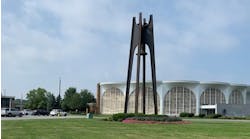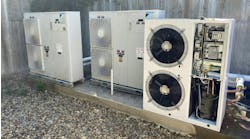Touring the heating systems at McMurdo Station in Antarctica with Mike Blachut, veteran HVACR technician, as my guide is like touring Disneyland with Walt Disney himself. On our excursion, we examined all of the building systems in the main structure that contain the commercial kitchen and dining room for 1,000 people, a small store, barbershop, administrative offices and community computer center. The main structure also has an attached dormitory that houses up to 300 people. Of course, the most interesting systems are the boilers.
It seems that there is nothing that Mike hasn't done at McMurdo Station during his 15-year tenure. He knows the heating, cooling, refrigeration and power generation systems inside and out. He can explain everything from why the steam boiler in the main building is expected to provide very little heat to how to keep the favorite machine — the Frosty Boy ice-cream machine — on the station working.
McMurdo Station is home to about 1,000 people during the summer months (October through February) in the Southern Hemisphere. No one is a permanent resident — scientists come to do research for as little as a few weeks. The support employees, everyone from aircraft pilots to cooks and janitors, live here for a few months. About 100 hardy souls stay during the winter and may stay longer than a year.
There are about 50 buildings at McMurdo, all heated with jet fuel. The burners are like ordinary oil burners in North America. The lower Btu content (about 127,000 Btu per gallon in lieu of the 144,000 Btu per gallon in North America) is compensated for by higher pump pressure at the burner.
There are several unique heating challenges in Antarctica. One, of course, is the extremely cold temperatures. Winter temperatures fall below -30°F, before wind chill.
Another challenge is the wind. A barometric damper on a flue is designed for normal conditions in North America. In Antarctica, there are days when the wind blows at 40 to 50 mph with gusts up to 70 mph or greater. That plays havoc with the flue draft. The flame can be “pulled” away from the burner. Once the flame goes out, the building cools rapidly.
As a solution, when the temperature drops in an office building or unoccupied science building during the night, an alarm calls the maintenance mechanic.
On one building, located on a hill, the wind knocked out the boiler so often that two barometric dampers were installed on the stack.
Summer is a separate heating challenge because temperatures are 50°F to 60°F warmer than in winter. Summer temperatures average 30°F to 40°F. While this is considerably warmer than most folks envision for Antarctica, it is still heating season.
“Back in the 1990s there were about 25 boilers at McMurdo,” commented Blachut. “There were five or six different manufacturers — Kewanee, York-Shipley, Bryan, Cleaver-Brooks and HydroTherm.”
Since then, 14 of these boilers were replaced and new boilers were installed in three new buildings. The new boilers are all modular and made by just a couple manufacturers.
There are several advantages to using these boilers: With one, two, three or four modular boilers in a building, the more than 60° variation in outside temperature can be addressed by adding and subtracting the number of modules.
Also, more breakdowns occur when it is really cold. The building can continue to be heated by some modules while others are being repaired.
Annual preventive maintenance and cleaning are done in the summer, but there is never a time when heating is not needed. With modular boilers, maintenance and cleaning can be done simultaneously.
If one section fails, it alone can be replaced rather than taking down the entire building's system. Plus, the boilers selected are very hardy for the Antarctic application.
A tremendous challenge at the McMurdo Station is ordering replacement parts. The supply ship comes just once a year — in February, after the ice breaks. That means the order cycle for parts is more than a year. Having more kinds of equipment means a bigger challenge when ordering parts in advance. With a limited number of manufacturers, there are fewer parts to order and store on the station.
And now, why is there a steam boiler not intended for heating at the station?
“This place was built by the Navy,” Blachut explained. “They had to have their steam kettles in the galley. Steam kettles have to have lots of steam.”
If you go into the kitchen, you see six giant kettles, three feet in diameter each. That's not a bad thing to have for feeding a thousand people per meal per day in Antarctica. And just as important, all the residents would say, is the Frosty Boy ice cream machine.
Carol Fey is a technical trainer and the author of books and a DVD on electricity, troubleshooting and controls. You can e-mail her at [email protected] or visit her website at www.carolfey.com. You can also visit her blog at: http://carolfey.blogspot.com.

